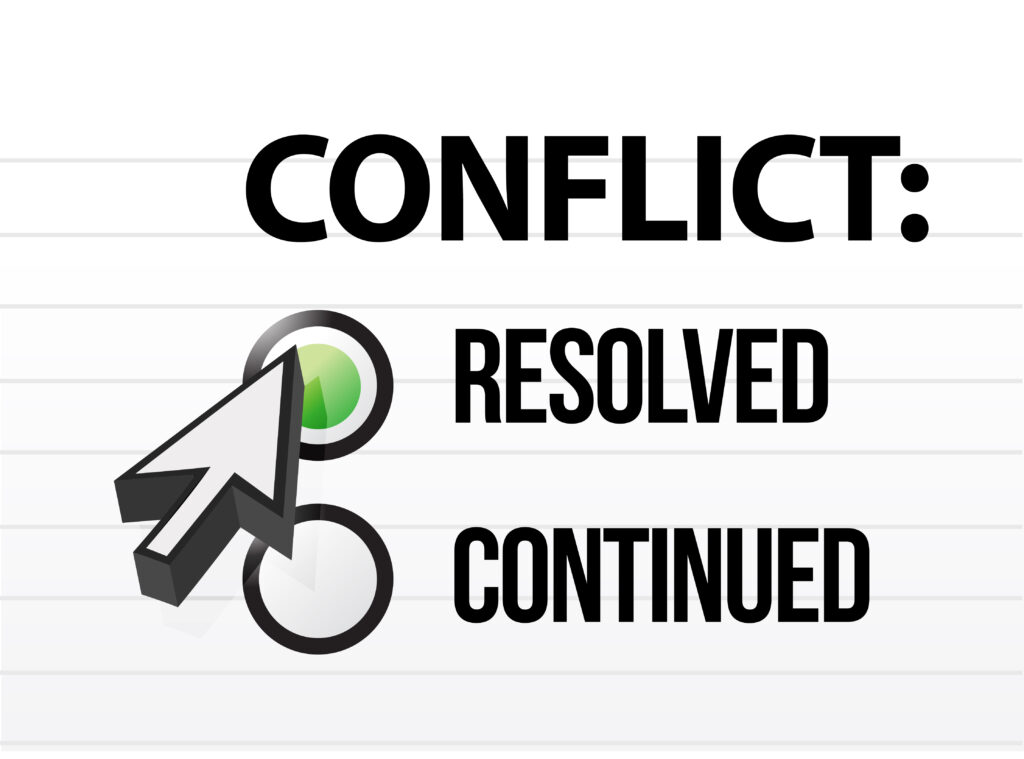Most people would rather get a root canal than initiate a conflict or problem discussion with a coworker, employee or family member. Unfortunately, most problems don’t just go away or get better on their own. In fact, they usually get worse. If you have an issue you need to discuss with someone else, it’s important to plan the conversation to help ensure the conversation stays on track and you achieve your goal: solving the problem.
Step 1: Set the Stage
-Set a date. Don’t blindside the other person with your planned, prepared, rehearsed conversation. Let the other party know what you want to talk about, and find a time that works for both of you to conduct the conversation.
-Choose a conducive location. Pick a place where both of you will be comfortable. If it’s a work situation, avoid using your office. Try a conference room or other neutral location. Also, think about privacy and find a location where you’ll be unlikely to be interrupted.
-Set ground rules for the conversation. Before beginning, discuss some guidelines for keeping the conversation on track, how to phrase feedback, and strategies both of you can use if you start feeling defensive.
Step 2: Start the Discussion
-As the initiator, your first comments are critical to the success of the conversation. You need to be prepared to let the other person know how important it is for both of you to maintain a good relationship and work together to help solve the problem. It’s important that both of you clearly understand what you’re there to talk about and how important it is that the issue is resolved.
-Ask the other person to share his/her views first. Think Covey’s famous habit, “Seek first to Understand, Then to Be Understood.” If specific examples are not provided, ask for them. Allowing the other person to have the “first word” shows that you’re there to listen, not dictate.
-Acknowledge what you’ve heard. If something the other person said is true, agree with it. If you disagree or perceive things differently, at least acknowledge what you’ve heard.
-Share your truth. Avoid contradicting the other person or telling him or her, “You’re wrong.” Instead, share your truth as you experienced it. Remember; think SPECIFIC, FACTUAL, and NON-JUDGMENTAL when you’re phrasing your comments.
-Once you both have a clear view of the situation, move on to problem solving. Although the discussion process can take a while, and I’m not advocating cutting the conversation short, I think people sometimes get stuck “debating” the details in an attempt to be right or to get the other person to agree with them. Remember that your goal isn’t to be right, or to win, or to get the other person to admit fault. The real goal is to move forward to a solution for the future.
Step 3: Work Together to Identify a Mutually Agreeable Solution
-Identify criteria for a mutually agreeable solution. Most people wouldn’t buy a car without having criteria established (cost, gas mileage, safety, etc.) before walking onto the car lot. For that same reason, don’t just start tossing out ideas for solving the problem. First, identify what a good solution looks like.
– Work together with the other person to come up with possible solutions. Again, as an initiator, allowing the other person to share his or her thoughts first shows that you’re open to input and not there with a pre-planned “agenda.” Then, share any additional solutions you’ve identified.
-Work together to identify which solution (or combination of solutions) best fits the criteria you’ve established. Having already identified what a good solution looks like, review the ideas you’ve both come up with and see which one(s) best fit the criteria and meet both of your needs.
Step 4: Agree on a Solution and Establish a Plan for Implementation
-It’s not enough to just agree. Work teams are notorious for ‘head nod” agreements where everyone agrees with a solution, but no one actually implements it. To ensure you’ll actually implement your solution, you have to have a plan.
-Who, What, When, How. The implementation plan needs to be specific. Each party needs to identify what he or she will do and how he or she will do it. Deadlines are a great motivator and give you an opportunity to check back in with each other. You might say, “Let’s give this a try for two weeks and meet again July 7 to see how we both feel things are going.”
-Follow up. A follow-up meeting allows you to check in is critical to the success of a solution. It allows you to identify what is and isn’t working and to tweak the solution, or even start the whole process over again if the solution hasn’t worked at all.
Although these steps are simple, they’re not always going to be easy. However, taking the time to prepare for the conversation up front, the greater the chance the conversation will go well and you and the other person will come up with a successful solution to the issue at hand.








Amy’s blog on four steps to resolving conflict is a helpful process that will enable employers to deal with issues in a fair and humane way. With the proper follow thru it should affect positive change in the workplace relationship.